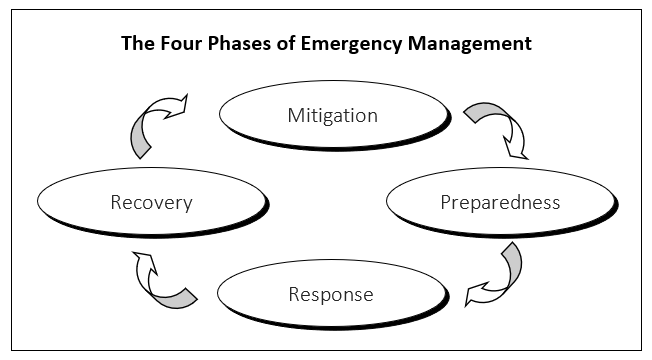
During the recent Bomb Cyclone that hit the Midwest in March, the Rocky Mountain ADA Center was inundated with calls from individuals with disabilities and businesses. These calls were related to the rights and responsibilities during emergency situations. The U.S. Department of Justice has several ADA related documents related to Emergency Preparedness & Response. The ADA National Network also has several factsheets and information related to Emergency Preparedness.
As with emergencies everywhere, they are often unexpected. The role of emergency preparedness is to protect people and property from all types of hazards. The Federal Emergency Management Agency (FEMA) is the agency responsible for responding to national disasters. They also help state and local governments and individuals prepare for emergencies.
Emergency management programs are usually part of state and local governments. According to FEMA, emergency management has 4 phases, namely: Mitigation; Preparedness; Response; and Recovery in that:
- Mitigation that focuses on preventing future emergencies or minimizing their effects;
- Preparedness on how to handle emergencies;
- Response to save lives and prevent further property damage in emergency situations; and
- Recovery includes actions taken to return to a normal or an even safer situation following an emergency.

Offices of Emergency Management of local and state governments meet to draw up emergency preparedness programs. Typically, they draw up comprehensive plans. However, a vital question appears here: Are individuals with disabilities included in these planning sessions?
The Americans with Disabilities Act (ADA) is clear in that state and local government programs should ensure that all emergency-management operations comply with federal civil rights laws and emergency and disaster-relief plans provide meaningful access to the whole community.
There is an useful ADA Guide for Local Governments on Making Community Emergency Preparedness and Response Programs Accessible to People with Disabilities. A critical component in this guide is that during planning, people with different types of disabilities (e.g. mobility, vision, hearing, cognitive and other disabilities) should be involved in all phases of emergency management plans.
A disability inclusive Emergency Preparedness Planning has two main objectives:
- Ensure that the functional needs of people with disabilities are adequately addressed prior to an emergency, enabling emergency responders to make informed decisions regarding the best use of available resources.
- Ensure that people with disabilities are included in the emergency-planning process at all levels of government and the private sector so they can offer their insights, knowledge, and resourcefulness.
So the most important part of any effective Emergency preparedness plan is the involvement of individuals with disabilities in all the phases of Emergency management. It is here that the disability community’s adage of Nothing about Us without Us should be heeded. The inclusion of persons with different types of disabilities in all aspects of Emergency planning will ensure the full integration and inclusion for everyone in the community.